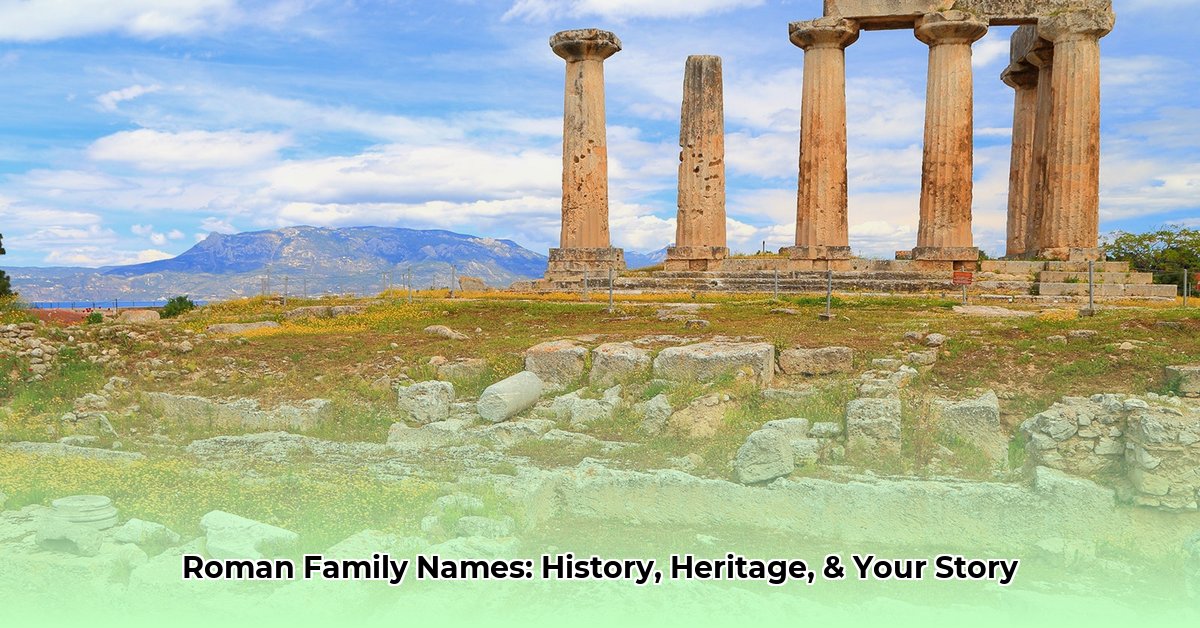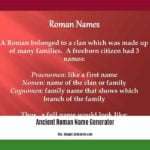Ever pondered the profound significance of a name? For the ancient Romans, a name was far more than a mere identifier; it was a sophisticated social blueprint, meticulously detailing an individual’s lineage, social standing, and unique identity. Imagine navigating a world where your “first name” was a private detail reserved for your closest kin, while your family name, or nomen, was a public declaration of your clan’s crest, instantly signaling centuries of shared history. Learn more about these fascinating Roman surnames. Then came the cognomina—those enduring nicknames that could immortalize a personal quirk, a heroic achievement, or even an ancestor’s profession, often becoming hereditary and shaping future generations.
These names were not static artifacts; they were dynamic entities that evolved over time, influenced by everything from noble ancestry and strategic mythological claims to grand military triumphs and shifting imperial decrees. Join us on an illuminating journey to unravel the intricate secrets embedded within ancient Roman family names, exploring how this rich tapestry of nomenclature continues to echo and resonate through our modern world, perhaps even within your own family history.
Decoding the Roman Naming System: The Tria Nomina and Beyond
The very bedrock of a Roman citizen’s identity rested upon a precise and deeply systematic naming structure. For male citizens, this typically involved three distinct parts, collectively known as the tria nomina (“three names”). Comprehending each component is paramount to fully grasp a Roman’s place within their intricate social fabric.
The Praenomen: The Intimate Personal Identifier
The praenomen served as a personal name, functionally similar to our contemporary first names. However, unlike today’s expansive array of choices, Romans traditionally selected from a surprisingly limited pool of common praenomina, such as Gaius, Lucius, Marcus, or Titus. This deliberate scarcity meant that knowing someone’s praenomen often signified a close, familiar relationship—a privilege usually reserved for family and intimate friends. It streamlined communication in a society that valued tradition and clear social recognition, preventing the confusion that a wider range of names might create.
The Nomen: The Indelible Mark of the Clan
Arguably the most crucial element, the nomen functioned as the family name, unequivocally identifying an individual’s gens, or clan. More than just a simple tag, it was a profound declaration of belonging, linking you to a vast, intricate network of ancestors, shared customs, and collective responsibilities. To bear a nomen like Julius, Cornelius, Fabius, or Valerius was to inherit centuries of Roman history, often accompanied by significant privilege, political influence, and an unwavering expectation of ancestral duty. These were the names that defined the powerful Roman families, like the Aemilii or Claudii, often considered the “original influencers” of Rome, whose prestige was built over generations.
The Cognomen: Nicknames That Forged Legacies
Initially, the cognomen began as a personal nickname, often highlighting a distinct characteristic or a notable event. Was “Rufus” indeed a redhead (rufus meaning “red”)? Was “Cato” so named for his renowned shrewd wisdom (cato meaning “wise”)? Did “Balbus” literally have a stammer (balbus meaning “stammerer”)? These descriptive epithets, however, frequently became hereditary, serving to differentiate distinct branches within a burgeoning gens. An agnomen, an additional honorary title, could even be appended, celebrating a monumental achievement, such as “Africanus” bestowed upon Scipio for his pivotal victories in Africa against Carthage. This flexible system allowed for vital individual distinction and recognition within the overarching family framework, often inspiring individuals to strive for greatness to uphold the honor of their name.
Names, Status, and Societal Blueprint: Decoding Roman Social Signals
In the meticulously stratified Roman society, your name was an immediate and public reflection of your social standing—an undeniable declaration of your birthright, accumulated wealth, and sphere of influence.
Patricians, Plebeians, and the Shifting Tides of Power
The most prominent citizens, the Patricians, typically bore elaborate, multi-layered names, each component a testament to their aristocratic heritage and ancient lineage. These complex names underscored their exclusive status, often claiming direct descent from Rome’s earliest founders. Plebeians, the common populace, generally possessed simpler names, mirroring their more straightforward social roles.
However, Roman society was far from static. As the Republic evolved, powerful plebeian families rose in prominence, gaining greater rights and influence. Successful military leaders and astute politicians from diverse backgrounds began to challenge the traditional patrician dominance. This dynamic social evolution meant that names, too, could reflect remarkable upward mobility, demonstrating the changing power dynamics and the gradual blurring of class lines that characterized Roman history.
Freedmen: A Name, A New Horizon
For freedmen—individuals who transitioned from the bondage of slavery to the newfound complexities of freedom—naming conventions provided a poignant illustration of their transformed standing. Upon manumission (formal release), a freedman would typically adopt the praenomen and nomen of their former master, retaining their original slave name as their cognomen. For example, a slave named “Dama” freed by a Lucius Cornelius might become “Lucius Cornelius Dama.” This practice emphasized their newfound liberty while respectfully acknowledging their past and their patron’s crucial role in their manumission, frequently shaping their future opportunities and connections within Roman society. It was a tangible mark of their integration, albeit on specific terms, into the Roman citizenry.
Women’s Names: Simplicity, Status, and Familial Linkage
Roman women’s naming conventions were notably simpler than those for men, yet deeply symbolic of their societal position. A woman typically adopted the feminine form of her father’s nomen. For instance, a daughter of a Julius would simply be known as Julia, a daughter of a Cornelius as Cornelia, or a daughter of a Livius as Livia. To distinguish between sisters within the same family, additional descriptors like “Maior” (the elder) or “Minor” (the younger) might be appended, or numerical indicators like “Secunda” (second) or “Tertia” (third). This apparent simplicity underscored the male-dominated structure of Roman society, where a woman’s primary identity and social standing were inextricably linked to her prestigious paternal lineage. Despite this, women, particularly those from powerful families like Livia Drusilla, wife of Emperor Augustus, wielded significant political and social influence through their familial connections, even if their names were less elaborate.
| Social Group | Naming Convention | Social Implication |
|---|---|---|
| Male Citizen | Tria Nomina (Praenomen, Nomen, Cognomen) | Signified full Roman citizenship, aristocratic or established lineage, and the full spectrum of legal rights and social status. This complex structure was a public display of family prestige and history, often influencing political power and military standing. |
| Female Citizen | Feminine form of Father’s Nomen (e.g., Julia for a daughter of a Julius); sometimes with an additional descriptor. | Reflected direct familial ties and social standing primarily through her father’s lineage. While simpler, her name directly connected her to a powerful or respected gens, granting her indirect influence through her family and husband’s status. |
| Slave | Single name (often assigned, sometimes from Greek or regional origin, or descriptive). | Denoted a complete lack of legal personhood and social status. Lacked the tria nomina. Their names were often simple, practical, or reflected their origin or a physical trait, emphasizing their position as property rather than citizens. |
| Freedperson | Adopted former owner’s Praenomen and Nomen; retained original slave name as Cognomen. | Indicated newfound freedom and a formal, lasting connection to their patron (former owner). This system solidified their legal transition to citizen status (though often with limitations) and provided a crucial social network, vital for navigating their new life within Roman society. Their name was a badge of their unique journey, showcasing progress and allegiance. |
Myth, Lineage, and Imperial Shifts: The Dynamic Evolution of Naming
Roman names were anything but fixed; they underwent profound transformations, influenced by a compelling blend of ancient myths, political ambition, and sweeping imperial decrees.
Mythological Connections: Laying Claim to Divine Ancestry
Romans frequently infused their naming practices with profound mythological connections, often strategically claiming direct descent from revered gods or legendary heroes. This was far from mere fantastical boasting; it served as a powerful, legitimizing move to elevate their family’s prestige and solidify their political power. For example, the venerable Fabii family claimed a direct link to Hercules, the demigod of strength, while the illustrious Julii famously traced their lineage all the way back to Venus, the goddess of love, via her son Aeneas, the mythical founder of Rome. This deeply ingrained cultural practice reveals a prevalent belief system where divine favor and heroic origins bestowed immense social capital and undeniable authority.
The Empire’s Influence: When Naming Became a Complex Tapestry
As the Roman Republic transitioned into a vast and sprawling Empire, naming conventions grew increasingly complex and expansive. Emperors, keen to solidify their legitimacy and authority, frequently adopted names that linked them to revered predecessors or significant historical figures. By the 3rd century CE, names could become intricate tapestries woven from imperial titles, religious allusions, lengthy strings of family connections, and even honorary distinctions.
A pivotal moment arrived in AD 212 with the Constitutio Antoniniana, an edict issued by Emperor Caracalla that granted full Roman citizenship to almost all free inhabitants of the Empire. This unprecedented act dramatically expanded the pool of citizens, leading to a proliferation of shared praenomina and nomina (such as Marcus Aurelius), which consequently diminished their distinctiveness as identifiers. As a result, the cognomen often became the primary and most significant identifier, distinguishing individuals from the swelling ranks of citizens who now shared prestigious family names. This shift underscores how administrative changes could profoundly reshape cultural practices, including naming traditions.
Tracing Roman Family Origins Today: Unlocking the Past
For those intrigued by how to determine Roman family origin or trace potential ancient connections, the process involves careful examination of surviving historical records and a nuanced understanding of Roman naming conventions. While a direct, unbroken line to a specific ancient Roman gens is exceedingly rare for most modern individuals, understanding the methodologies provides critical insights into historical research.
Steps and Considerations to Determine Roman Family Origin:
- Examine Primary Inscriptions: Inscriptions found on tombstones (epitaphs), monumental arches, public buildings, and military diplomas are invaluable. These often contain full names, titles, familial relationships, and even places of origin, providing direct epigraphic evidence of ancient lineage and social status. Dedicated epigraphic databases can be powerful tools.
- Consult Genealogical and Prosopographical Records: While a complete “family tree” for ancient Romans is rare, existing genealogical records compiled by historians and specialized academic databases (prosopographical studies) can offer pathways to tracing known Roman family trees and their branches. These resources often focus on elite families due to the survival of more records.
- Study Onomastics (The Scientific Study of Names): Onomastics analyzes the patterns, origins, and meanings of names to reveal connections and historical trends. Understanding the evolution of names, particularly cognomina and their regional variations, can be profoundly insightful. For example, certain cognomina might be common only in specific Roman provinces or among particular social groups.
- Consider Socio-Historical Context: Interpreting Roman names accurately requires a deep understanding of the prevailing social, political, and cultural landscape of the specific period. For instance, a particular cognomen might signify a specific military achievement, a physical attribute, or a geographical origin tied to an individual’s unique story.
- Beware of Common Misinterpretations and “Critical Mistakes”:
- Overlooking the Agnomen: Misinterpreting or overlooking the importance of an agnomen (honorary additional cognomen) could mean missing a critical piece of information about an individual’s extraordinary accomplishments and the honor bestowed upon their family.
- Simplifying Women’s Names: Assuming a Roman woman’s lesser importance due to her seemingly simpler name ignores her direct connection to a prestigious paternal lineage, which often afforded her considerable influence within Roman elite society.
- Anachronism: Applying modern naming conventions or social interpretations to ancient Roman practices can lead to significant errors in genealogical research and historical analysis. The Roman system operated on entirely different social logic.
Analyzing these ancient names allows us to unlock a wealth of information about Roman society, its values, its power structures, and the fascinating individuals who built and sustained one of history’s most influential, long-lasting civilizations.
The Enduring Echoes of Roman Names in the Modern World
By the 6th century CE, as the Western Roman Empire gradually waned and its centralized institutions fragmented, the elaborate Roman naming system slowly crumbled. However, the profound legacy of ancient Roman family names did not vanish; instead, it permeated the linguistic and cultural foundations of European naming conventions, influencing the very structure of personal identification for centuries to come. Many of our modern names, particularly surnames, trace their etymological roots directly back to Roman nomina, cognomina, or praenomina. Think of pervasive names like Julius, Cornelius, Marcus, and Felix, or common English surnames derived from Latin elements, such as Paul (from Paulus), Martin (from Martinus), or even the subtle Roman echoes in place names and scientific classifications.
This enduring influence acts as a powerful testament to the indelible impact of Roman culture and its administrative ingenuity on Western civilization. From academic historical research to modern legal contexts where names carry significant weight and cultural connotations, the echoes of ancient Rome persist. Exploring ancient Roman family names offers not just a historical exercise but a unique, tangible window into the lives, aspirations, and profound legacies of those who painstakingly built an empire that irrevocably shaped the course of human history and still whispers to us through the very words we use to identify ourselves today.
Key Takeaways:
- Roman naming was a highly sophisticated system (tria nomina), meticulously reflecting social status, intricate lineage, and distinct personal attributes.
- Each component—the intimate praenomen, the clan-defining nomen, and the descriptive cognomen—offered unique, layered insights into a Roman citizen’s world.
- Naming conventions varied significantly by social class, with patricians displaying elaborate names and freedmen adopting elements of their former masters’ names to signify their new status.
- Women’s names, while simpler, profoundly underscored their direct familial connections and social standing within a male-dominated society.
- Understanding the evolution and nuances of Roman names provides crucial, multifaceted insights into their complex society, enduring values, and dynamic cultural dynamics.
- The legacy of Roman names continues to shape modern naming conventions, demonstrating their lasting cultural and linguistic impact.
Citations:
- https://en.m.wikipedia.org/wiki/List_of_Roman_nomina
- https://kidadl.com/name-inspiration/babies/roman-last-names-with-meanings-and-history
- https://honeyname.com/roman-last-names/
- https://www.behindthename.com/names/usage/ancient-roman
- https://teamgroupnames.com/roman-last-names/
















